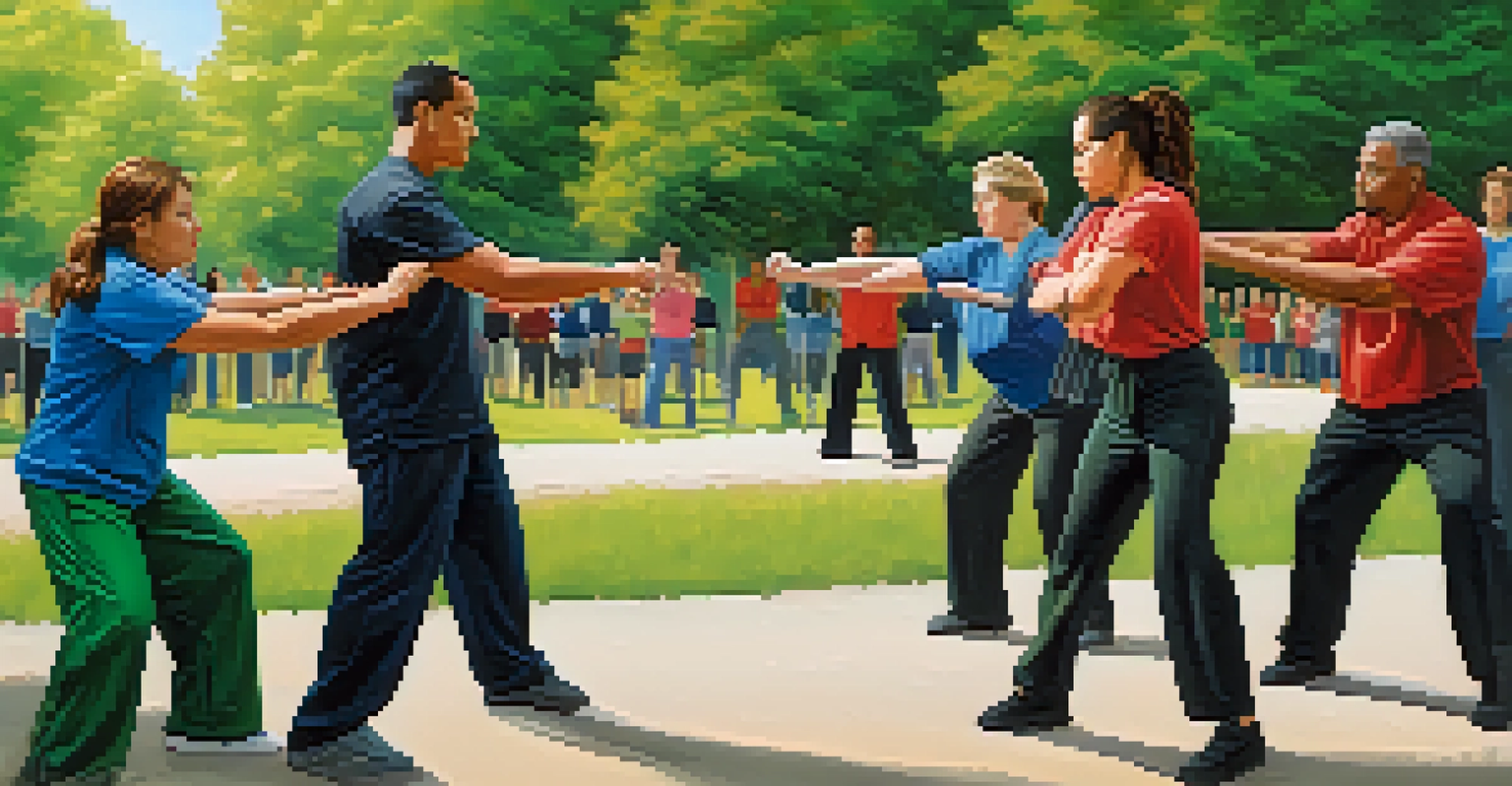Self Defense Training: Adapting for Urban and Rural Needs

Understanding the Unique Challenges of Urban Environments
Urban environments present a unique set of challenges for self-defense training. With high population density, the likelihood of encountering potential threats can feel more pressing. Busy streets, crowded public transport, and narrow alleyways require different strategies compared to open spaces, as one must be mindful of surroundings and bystanders.
In a dangerous situation, the best defense is to avoid it altogether.
In cities, the presence of various factors like noise, distractions, and the fast pace of life can complicate self-defense situations. This makes it crucial for individuals to learn not just physical techniques but also mental awareness. Being able to assess situations quickly and effectively is as vital as knowing how to defend oneself physically.
Related Resource
Moreover, the legal implications of self-defense can vary greatly in urban areas. Many cities have specific laws regarding self-defense that practitioners need to be aware of, making legal education an essential component of urban self-defense training.
Key Skills for Urban Self Defense Training
When training for self-defense in urban settings, specific skills become paramount. Techniques such as situational awareness, verbal de-escalation, and quick escapes are essential. Practicing how to navigate through crowded areas while remaining alert can make a significant difference in a threatening situation.

Moreover, using the environment to your advantage is crucial. For instance, learning how to utilize objects around you, like a bag or umbrella, can help in defending against an attacker. This creativity in using everyday items ensures that one is prepared to react even when they may not have traditional self-defense tools at hand.
Urban Self-Defense Requires Awareness
In urban environments, mastering situational awareness and quick response is crucial due to high population density and various distractions.
Additionally, urban self-defense training often incorporates scenario-based drills, simulating real-life situations that practitioners may face. This realistic approach not only builds confidence but also enhances instinctive reactions, preparing individuals for the unpredictability of urban threats.
Rural Self Defense: Understanding the Landscape
In contrast, rural areas present their own unique challenges when it comes to self-defense. The wide-open spaces can create a false sense of security, but the isolation can be a significant factor if a threat arises. In these settings, individuals may find themselves far from help, making self-defense skills even more critical.
Self-defense is not just about physical techniques; it’s about awareness, prevention, and knowing your rights.
Rural environments also mean fewer witnesses and resources, which can heighten the stakes in a self-defense scenario. Understanding how to navigate these settings, whether it's dealing with wildlife or potential human threats, is essential. This means that self-defense training in rural areas often includes outdoor survival skills as well.
Related Resource
Moreover, community ties are stronger in rural settings, which can both help and hinder self-defense situations. While neighbors may come to each other's aid, there can also be a reluctance to seek help from law enforcement due to close-knit relationships. Training should address these dynamics to prepare individuals mentally and physically.
Essential Skills for Rural Self Defense Training
Rural self-defense training emphasizes skills that differ from urban techniques, focusing on practical strategies for wide-open spaces. Learning to recognize potential threats in nature, such as wild animals or unfamiliar people on secluded paths, is critical. Practitioners should also develop skills for self-defense in various terrains like forests, fields, and even water bodies.
Additionally, physical conditioning is important in rural self-defense training. The ability to run long distances or climb over obstacles may be necessary to escape a threat. Training often includes engaging in activities that boost stamina and agility, ensuring individuals are ready for various physical challenges.
Rural Defense Focuses on Practical Skills
Rural self-defense training emphasizes physical conditioning and the use of improvised weapons to navigate wide-open spaces and potential threats.
Furthermore, the use of improvised weapons can be a key component of rural training. Understanding how to utilize everyday items found in a rural environment, such as a stick or a rock, can provide an advantage in a self-defense situation. This adaptability can empower individuals to feel more secure in their surroundings.
The Role of Community in Self Defense Training
Community plays a significant role in both urban and rural self-defense training. In urban settings, communities can organize workshops that promote awareness and safety, bringing people together to learn and share experiences. This collective approach not only builds skills but also fosters a sense of security among residents.
In rural areas, community ties can serve as a powerful support system for self-defense training. Neighbors often look out for one another, and sharing skills can lead to a stronger, more prepared community. Group training sessions can also help individuals learn from each other’s experiences and enhance their capabilities collectively.
Related Resource
Additionally, communities that prioritize self-defense education can empower individuals, especially women and vulnerable populations. By creating a culture of preparedness, communities foster resilience and confidence among their members, making it clear that safety is a shared responsibility.
Legal Considerations in Self Defense Training
Understanding the legal landscape surrounding self-defense is crucial for both urban and rural practitioners. Laws can vary significantly between regions, making it necessary to know the rights and responsibilities associated with self-defense. This knowledge can help individuals make informed decisions in high-pressure situations.
In urban areas, self-defense laws may be stricter, often requiring individuals to prove that their response was proportional to the threat faced. Training should include discussions about these legal implications, ensuring that practitioners understand when and how to apply self-defense techniques legally.
Community Support Enhances Training
Both urban and rural communities benefit from collective self-defense training, fostering resilience and safety among residents.
Similarly, rural practitioners must also be aware of their legal rights, especially in scenarios involving wildlife or potential intruders. The more informed individuals are about the laws in their area, the better prepared they will be to protect themselves without overstepping legal boundaries.
Choosing the Right Self Defense Training Program
When selecting a self-defense training program, it’s essential to consider the environment in which you live. Urban programs may focus more on quick escapes and situational awareness, while rural programs might emphasize physical endurance and improvised weapons. Identifying what skills are most relevant to your daily life will guide your choice.
Additionally, look for programs that offer a blend of physical techniques, mental preparedness, and legal education. A well-rounded program will not only teach you how to defend yourself but also equip you with the knowledge to navigate potential threats wisely. It’s also beneficial to seek out instructors with experience in both urban and rural settings.

Finally, community involvement can enhance the effectiveness of your training. Consider programs that encourage group participation, creating a supportive environment where you can learn alongside others. This camaraderie can boost motivation and reinforce the importance of self-defense skills within your community.